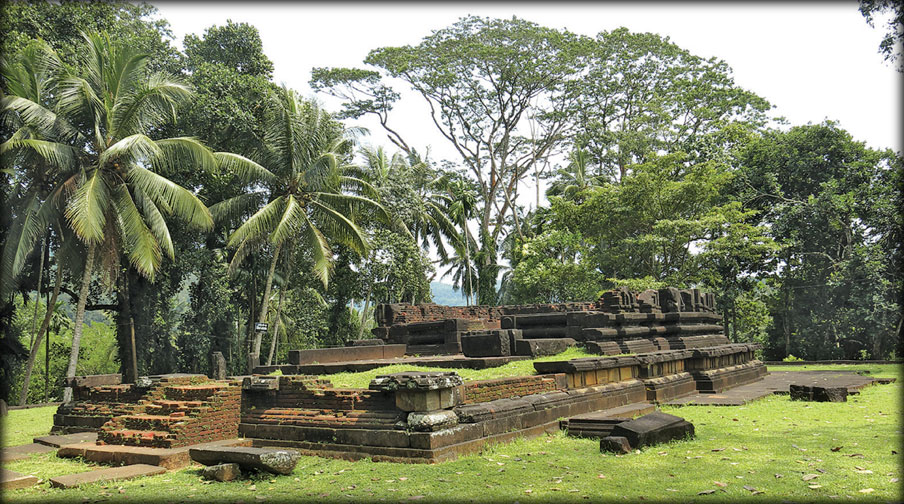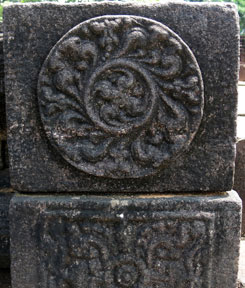|

The three platformed Berendi Kovil as seen today. |
Stone marvels of Berendi Kovil
Story and pictures by Mahil Wijesinghe
On a short weekend when time is premium but the urge to do some
exploring is great, the best thing you can do is take a one-day leisure
excursion to historic sites around the 16th Century medieval Kingdom of
Sitawaka. A 90-minute journey from Colombo will bring you to Avissawella,
the area once known as the Kingdom of Sitawaka, though little remains of
the glorious kingdom today.
The monuments hinting at a great past included the ruins of the
Sitawaka Fort, the palace and burial ground of King Rajasinghe I,
Pethungoda katu una pandura (thorn bamboo grove) and the stone marvels
of Berendi Kovil. Among the sites and scattered ruins of Sitawaka, it is
perhaps the Berendi Kovil that captures one's attention, especially so,
because of that elaborately carved stone sculptures that are well
preserved and have been restored by the Department of Archaeology.
|

The carving of flower pots |
The best way to get to the site is by proceeding about three
kilometers from Avissawella on the Hatton Road to the Thalduwa town with
the Sitawaka Oya meandering alongside. Given that we weren't travelling
far, we set off at a leisurely pace, taking in the sight of women and
children gathering at the banks of Sitawaka Oya for their morning
ablution. Our destination was the historic Berendi Kovil, located on a
small hillock, overgrown with thicket on the banks of the Oya.
Although the small iconic signboard of the Department of Archaeology,
erected alongside the main road, shows the way to the Kovil, it is
easily overlooked because of the numerous banners and boards crowding
the area.
However, being alert to this fact, we spied the board, took the right
turn, parked the vehicle and walked about half a kilometre on a narrow
carpeted road until we found the entrance to the Kovil, which is located
on a hill.
Kalamediriyan Wala
Walking to the Kovil, we saw several stone carvings, obviously
belonging to the Kovil, lying half buried in the private tea estates
alongside the road, indicating there are numerous ruins still buried in
the vicinity of the Berendi Kovil although it had been restored many
years ago by the Department of Archaeology.
The waters of Sitawaka Oya flow down to the Kelani River. The ruins
of the Berendi Kovil are located on the bank of the section of Sitawaka
Oya known as Kalamediriyan Wala. Berendi Kovil is said to have derived
its name from the Bahirava, a deity manifestation of God Shiva.
|

One of the lion figures |
King Mayadunne was the first ruler of the Sitawaka Kingdom, followed
by his illustrious son Rajasinghe I, who came to be known as 'the brave
King Rajasinghe I, and is hailed in the 'Rajawaliya' as the 'King of
Lion'. The Rajawaliya pays tribute to the young Prince Tikiri Bandara
(as Rajasinghe was then known), who fought alongside his father King
Mayadunne to defeat the Portuguese and vanquish all other enemies, and
thereafter took the name Prince Rajasinghe.
Folklore and historical documents reveal that King Rajasinghe I,
stung by the collusion of the Sangha with the invading Portuguese,
renounced the faith of his forefathers and became a devotee of Hinduism.
The Sangha it is said, retaliated by blacking his name, accusing him of
murdering his own father, King Mayadunne. Contrite about the alleged
assassination of his father, King Mayadunne, an irreparable sin
according to Buddhism, King Rajasinghe I sought refuge in the Hindu
religion by becoming a Hindu convert. It is also said that King
Rajasinghe I built the Berendi Kovil to atone for the sin of fratricide.
Berendi Kovil, built in 1581-1593 AD on the banks of Sitawaka Oya, is
dedicated to God Siva. Several times larger than any of the Devales in
Polonnaruwa, it is considered the largest Hindu temple in the country.
Legend has it that 2,000 men were employed in its construction, which
lasted up to 20 years.
Atonement for guilt
The Kovil is said to have been constructed at the behest of
Arittakivendu Perumal, a Hindu and a learned person versed in astrology,
who became the king's adviser. It is said that Perumal advised the King
to build a kovil and divert Sitawaka Oya as atonement for the guilt he
felt about the accusations of killing his father.
 Remnants
of the elaborate stone work that once decorated the Berendi Kovil, give
a glimpse of what the Kovil would have looked like when it stood in all
its glory. The Kovil was built in three platforms from huge blocks of
stone. Like a Stupa, entry was through four- stone doorways. From a
distance, we could see three distinct platforms built upon each other on
the summit. The central platform which once stood on a plinth of lotus
petals was the Devale proper. Remnants
of the elaborate stone work that once decorated the Berendi Kovil, give
a glimpse of what the Kovil would have looked like when it stood in all
its glory. The Kovil was built in three platforms from huge blocks of
stone. Like a Stupa, entry was through four- stone doorways. From a
distance, we could see three distinct platforms built upon each other on
the summit. The central platform which once stood on a plinth of lotus
petals was the Devale proper.
 Although
a Hindu shrine, the Kovil's artistic images resonate with Buddhist
influence. A frieze of lion heads run right round the stone building,
while the lower platform is engraved with carvings of the Bo-leaf. Guard
stones lie tumbled near the inner sanctum, engraved with the flowering
pots and lotus medallions and blossoming scrolls decorate the entrance
to the final door. Most of the stone pillars had been decorated and
carved with beautiful floral motifs. Some are still intact and are
indeed awe inspiring sites. Although
a Hindu shrine, the Kovil's artistic images resonate with Buddhist
influence. A frieze of lion heads run right round the stone building,
while the lower platform is engraved with carvings of the Bo-leaf. Guard
stones lie tumbled near the inner sanctum, engraved with the flowering
pots and lotus medallions and blossoming scrolls decorate the entrance
to the final door. Most of the stone pillars had been decorated and
carved with beautiful floral motifs. Some are still intact and are
indeed awe inspiring sites.
Though destroyed by the Portuguese, the ruins of Berendi Kovil are
sufficient to tell a tale of a once grand Kovil that stood on the bank
of the Sitawaka Oya.
The Berendi Kovil was renovated by the first Commissioner of
Archaeology in Sri Lanka, H.C.P. Bell, on its discovery in 1896 in
dilapidated conditions. In 2003 the Department of Archaeology conserved
it to its original condition by replacing the misplaced stone blocks
with bricks. |

